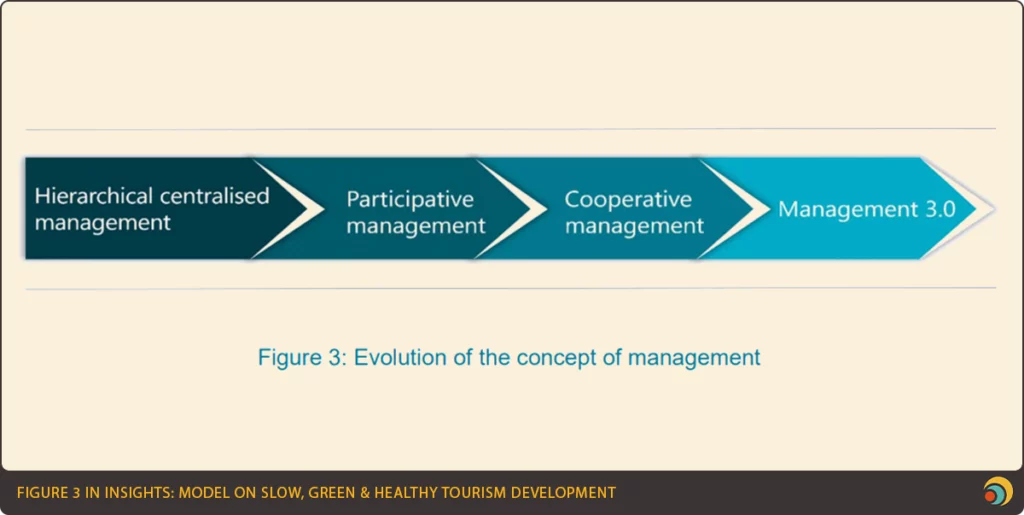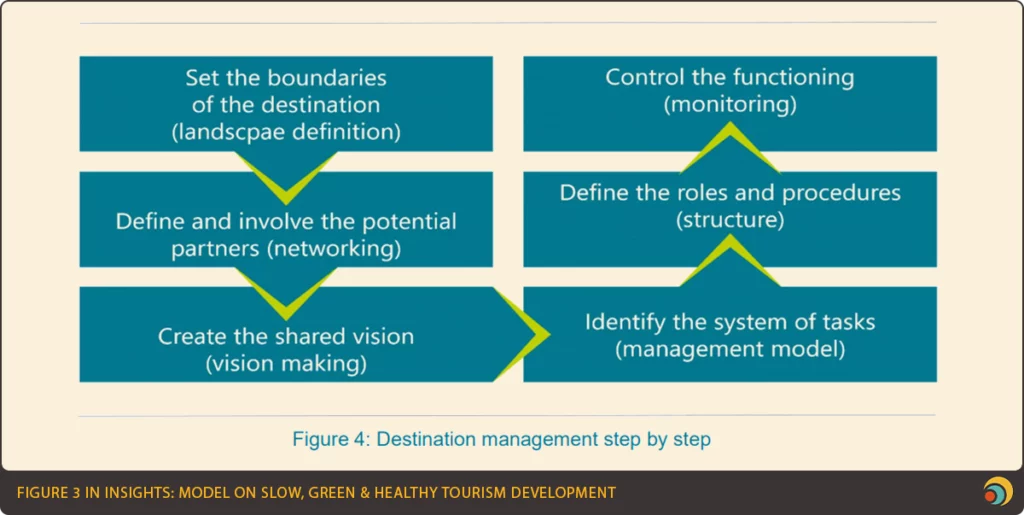Sustainable tourism is slow and green – since the 2010s, there is no debate about it. The last decade strengthened this standpoint as the consequences of climate change have entered our lives more evidently than before, making it a must to go green in every aspect. Additionally, the 2020-2021 pandemic pushed us to focus on living local. In this article we are going to explore the prospects of creating sustainable tourist destinations using lessons learnt from the INSiGHTS project’s Model on slow, green and healthy tourism. Additionally, BURST’s tourism expert, Edit Konok, provides us with an outlook on the latest trends and actualities.
Two years ago I had the luck to celebrate the spring holiday in the region of Friuli-Venezia, one of the most visited parts of Europe where the crown jewel of Venice is to be found. After one year of quarantine, it seems like an eternity ago, but I still have vivid memories of this trip, most of which are connected to the ‘Ciclabile delle Dolomiti’, a bicycle route in the mountainous part of the region. The good quality bicycle route, created on an unused railway offered a breathtaking view on the landscape, with picturesque old railway stations along the way – a scenery which is equally treasured in my mind as the Grand Canal and gondolas of Venice. I still remember pedaling the comfortable mountain bikes we rented and the taste of cappuccino bought in a local café. The end of our trip was a little village where wandering around, we bumped into the statue of the inventor of ice-cream, a local resident in the 1600s. Regarding the logistics, we found all the information needed on the webpage dedicated to this bicycle route, branded as the most beautiful bicycle route of the world.
If all tourist destinations had a similar offer up their sleeve, we would make a huge step towards slow and green tourism. Friuli-Venezia region managed to handle their portfolio so well thanks to a good coordination of their local opportunities. The INSiGHTS project aimed to help regions exploit their potential as well as Friuli-Venezia; producing a ‘Model on slow, green and healthy tourism development’. The Model’s focus is assisting municipalities in improving participatory governance frameworks, supporting bottom-up networks of tourism providers and generating quality-driven green tourism packages.

“Cooperative governance as a concept is not well applied in the Central European region, according to my experiences. Local municipalities – usually responsible for tourism development – typically lack the knowledge, tools, capability, practice and, in some cases, even the intention to implement real community planning. However, due to the Community-led Local Development programme, running in the 2014-2020 programming period, local municipalities could gain useful practices in bottom-up planning methods – the required methodology of the programme itself was multilevel stakeholder cooperation to create local development strategies. Based on these, we can expect an improving tendency in their attitude towards a participatory approach in tourism policies as well.” – says Edit, BURST tourism expert, based on her experiences in Hungary and the surrounding Central European region. The INSiGHTS’ Model contains a step-by-step guide for creating and managing local participatory governance networks. The most important factors are the ability to apply a transparent consensus building approach with the key stakeholders in the area and to have a clear view of the possible offer worth to be turned into a ‘corporate identity’.

Local products are important assets when it comes to sustainable tourism offers, also from a social and environmental point of view. “Slow tourism goes hand in hand with the support of local providers: these “gentle” tourists are more curious about the specialities and hidden treasures of the region; thus their consumption of goods and services turns more to local providers than that of mass tourism.” – according to Edit. Relevant studies and practices both show that the offer side has the means to progress, but the cornerstone is to make the demand side more sensitive to the aspects of sustainability and eco-consciousness. “Tourism offers will always be driven by demand. The reality is that the eco-conscious choices – both for products and services – are still expensive, and the majority is not willing and able to pay the extra price, at least not in Central Europe.” – argues Edit, adding that the movement towards sustainable tourism is slow and marginal at the moment, in proportion to the total supply.
The INSiGHTS Model showcases a progressive and successful good practice: the Schwäbisches Donautal Nature Tourism Master Plan. The Plan provides a strategic framework for tourism development and supports the effective marketing of the destination. The Swabian Danube Valley promotes the preservation of the natural and cultural heritage as an instrument for tourism development. This destination is a great example of how tourism frameworks based on stakeholder cooperation can transform perceptions on local tourism; moving from an unorganised, weak group of municipalities without a clear purpose into a strong, coordinated destination.

What is the secret of the above recipe? The great potential for day visits and short-breaks. for the more than 30 million people living within a radius of 90 minutes’ drive from the destination is surely one of them. However, when asking Edit whether targeting tourists based on geographical proximity can be a viable future for other regions as well after the pandemic, she is sceptical. “Most providers turned to domestic and local tourism during the pandemic. ‘Post-pandemic tourism offers’ will shift towards needs of solvent customers instead of serving local tourists by all means. Especially in Hungary and Central Europe, destinations which focused on foreign tourists will most likely turn back to their former business model. However, if the „transition” to domestic tourism was successful and profitable for a destination, the modified target group focus may partly persist after the pandemic.” Decision makers surely hope that the temporary shift towards ‘travelling local’ will survive and contribute to a paradigm change, resulting in a greener and more sustainable tourism scene.
The Integrated Slow, Green and Healthy Tourism Strategies publication prepared by Development Center of the Heart of Slovenia in the framework of the Interreg Danube – INSiGHTS project is available from now on BURST’s ISSUU platform.

Edit Konok is BURST’s knowledge source when it comes to cultural heritage, hospitality and tourism. European TA assistance type of expert projects assigned by national authorities, like the “ongoing evaluation” of the Interreg Hungary-Serbia and Hungary-Croatia IPA Cross-border Cooperation Programmes 2007-2013, contribution to the elaboration of the EEA and Norway Grants Mechanism 2009-2014, participation in the ex-ante evaluation of the Romania-Hungary Cross-border Cooperation Programme 2014-20, providing project evaluation tasks for various Hungarian regional development agencies in fields of her main interest like TDM capacity building and development, cultural heritage, medical and sport tourism.
